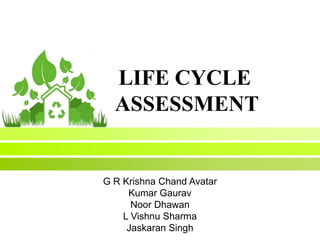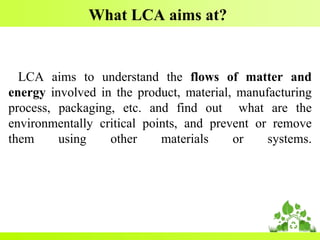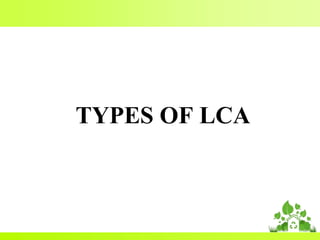Life Cycle Assessment
- 1. LIFE CYCLE ASSESSMENT G R Krishna Chand Avatar Kumar Gaurav Noor Dhawan L Vishnu Sharma Jaskaran Singh
- 2. Introductory Video on LCA
- 3. What is LCA? LCA stands for Life Cycle Assessment. It is a technique that tries to identify, measure and characterize different potential environmental impacts associated to each one of the stages of the life cycle of a product.
- 4. What LCA aims at? LCA aims to understand the flows of matter and energy involved in the product, material, manufacturing process, packaging, etc. and find out what are the environmentally critical points, and prevent or remove them using other materials or systems.
- 5. TYPES OF LCA
- 6. VARIANTS OF LCA 1. Cradle-to-Grave 2. Cradle-to-Gate 3. Cradle-to-Cradle 4. Gate-to-Gate 5. Wheel-to-Wheel 6. Ecology-based
- 7. CRADLE-TO-GRAVE Cradle-to-grave is the full Life Cycle Assessment from resource extraction ('cradle') to use phase and disposal phase ('grave').
- 8. CRADLE-TO-GATE Cradle-to-gate is an assessment of a partial product life cycle from resource extraction (cradle) to the factory gate (i.e., before it is transported to the consumer)
- 9. CRADLE-TO-CRADLE Cradle-to-cradle is a specific kind of cradle-to-grave assessment, where the end-of-life disposal step for the product is a recycling process. It is a method used to minimize the environmental impact of products by employing sustainable production, operation, and disposal practices and aims to incorporate social responsibility into product development.
- 10. GATE-TO-GATE Gate-to-gate is a partial LCA looking at only one value-added process in the entire production chain.
- 11. WHEEL-TO-WHEEL Well-to-wheel is the specific LCA used for transport fuels and vehicles. The first stage, which incorporates the feedstock or fuel production and processing and fuel delivery or energy transmission, and is called the "upstream" stage, while the stage that deals with vehicle operation itself is sometimes called the "downstream" stage.
- 12. ECOLOGY-BASED Eco-LCA is a methodology that quantitatively takes into account regulating and supporting services during the life cycle of economic goods and products. It was designed to provide a guide to wise management of human activities by understanding the direct and indirect impacts on ecological resources and surrounding ecosystems.
- 14. WHAT CAN BE DONE WITH LCA? 1.Product or project development and improvement 2.Strategic planning 3.Public policy making 4.Marketing and eco-declarations
- 15. Processes involved in LCA
- 16. PHASES OF LCA STUDY
- 17. Phases of LCA study a) Phase of goal and scope definition b) Phase of inventory analysis c) Phase of impact assessment d) Phase of interpretation
- 18. Phase of goal and scope definition This is a key step and the ISO standards require that the goal and scope of an LCA be clearly defined and consistent with the intended application. The goal and scope document therefore includes technical details that guide subsequent work: ->
- 19. Steps involved in Goal and scope definition: ŌĆó Product system to study ŌĆó The functions of the product system ŌĆó The functional unit ŌĆó The system limits ŌĆó Assumptions ŌĆó Limitations ŌĆó Data Requirements
- 20. Phase of inventory analysis ŌĆśInventoryŌĆÖ literally means listing of products. Life Cycle Inventory (LCI) analysis involves creating an inventory of flows from and to nature for a product system. Inventory flows include inputs of water, energy, and raw materials, and releases to air, land, and water. It also involves data collection and quantification of needed input/output data.
- 21. Phase of impact assessment Understand and assess the magnitude and importance of potential environmental impacts. Environmental impact is an alteration of the initial characteristics of the environment caused by a project, work or activity It is the set of consequences for human health, welfare of the flora and fauna and the future availability of natural resources attributable to the input or output streams of a system.
- 22. STEPS INVOLVED This process comprises of the following procedures: ŌĆó selection of impact categories, category indicators, and characterization models; ŌĆó the classification stage, where the inventory parameters are sorted and assigned to specific impact categories; and ŌĆó impact measurement, where the categorized LCI flows are characterized, using one of many possible LCIA methodologies, into common equivalence units that are then summed to provide an overall impact category total.
- 23. Phase of interpretation ŌĆó Life Cycle Interpretation is a systematic technique to identify, quantify, check, and evaluate information from the results of the life cycle inventory and/or the life cycle impact assessment. The results from the inventory analysis and impact assessment are summarized during the interpretation phase. The outcome of the interpretation phase is a set of conclusions and recommendations for the study.
- 24. Interpreting ŌĆśINTERPRETATIONŌĆÖ According to ISO 14040:2006, the interpretation should include: ŌĆó identification of significant issues based on the results of the LCI and LCIA phases of an LCA; ŌĆó evaluation of the study considering completeness, sensitivity and consistency checks; and ŌĆó conclusions, limitations and recommendations.
- 25. A short clip on LCA

























